Where and when is it best to drill a well in the area: general rules + advice from experienced drillers
Your house does not have a central water supply, so why are you thinking about drilling a water well? But due to the lack of experience in this area, you do not know in which place of the site to arrange water intake, and when is it better to drill? Agree that all these questions are very important: the operational characteristics of the future water source depend on the answer to them.
We will help you find the right answers. Indeed, it is not so difficult to determine the optimal place on your own if you have the necessary knowledge and take into account the features of the site. In our article, general rules and norms are given that should be followed when choosing a place for a well. And also considered a variety of ways to search for groundwater.
So that you can choose the optimal time for drilling, we provide tips and recommendations of experts in this industry, providing information with photographs and videos that allow you to visualize the whole process.
The content of the article:
- Well location requirements
- Sanitary norms and regulations
- Point selection for drilling a water source
- Visual Groundwater Search Methods
- Empirical ways to find groundwater
- Reliable Exploration Drilling Search Method
- Unsuitable places for the well
- Well in the basement of the house
- Optimum time for drilling
- Conclusions and useful video on the topic
Well location requirements
When choosing a place for drilling, many factors are taken into account: the geological features of the site, its topography, the influence of hydrological factors, and the location of the remaining objects of economic activity.
In addition, the convenience of the location of the future is important. water supply, which will allow in the future to operate it without problems.
The selected location for the well must meet the following requirements:
- the presence of an aquifer;
- convenient location for water intake;
- the possibility of a water supply device;
- providing access to the drilling machine and other equipment for servicing the well;
- compliance with sanitary standards;
- lack of power lines, underground utilities.
Also, at the stage of choosing a location for a well, it is worth considering how pumping equipment will be connected, i.e. take into account the presence of power lines. If in the future you plan to lay a surface water supply from the well, it is desirable that the slope of the site does not exceed 35º.
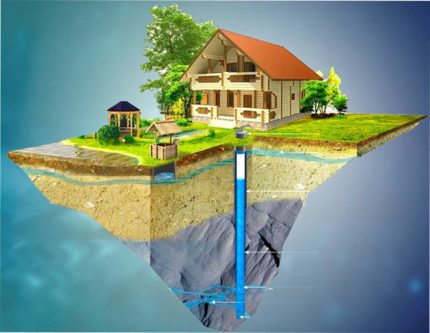
Sanitary norms and regulations
Sanitary standards for aquifers are described in documents SanPiN No. 2.1.4.110-02. Of course, first of all, this document concerns large water intakes that provide water to settlements or individual enterprises and areas.
However, when constructing a private well in your own area, it is recommended to adhere to sanitary standards.
In accordance with SanPiN standards, the minimum distance from the source of water intake to residential buildings is 30 m for protected groundwater, and 50 m for unprotected groundwater. It is clear that in the conditions of private construction it is impossible to comply with these standards.
Therefore, you should pay attention to the following rules:
- Directly near the well in the area of at least 4x4 m in size there should not be any residential and commercial buildings.
- Within a radius of at least 300 m, industrial enterprises, large roads, landfills, cattle burial grounds, cemeteries should not be located.
- In a radius of at least 20 m there should not be garden crops that are irrigated using chemical fertilizers.
- The well should be as far away as possible from cesspools, septic tanks, compost heaps and similar objects. This applies not only to sources of possible pollution located on your site, but also to neighboring ones.
It is practically impossible to ensure full compliance with even these standards, so if water from the well will be used not only for irrigation, but also for drinking needs, care must be taken to clean it. Also, a solution in this situation could be drilling a deeper artesian-type well.
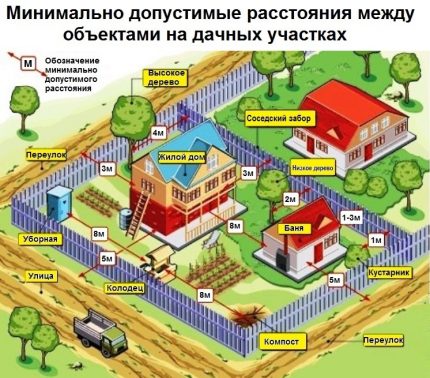
Point selection for drilling a water source
When choosing a location for well drilling crucial is the presence of aquifers. Many factors will depend on the depth of their occurrence: the footage of the mine, the method of drilling, the need for cementing and the installation of filters, etc.
Let us consider in more detail what types of groundwater can serve as a water source for household needs and how to determine their depth.
Consider four types of groundwater that can become a source of water supply at your site:
- High end - the upper aquifer, lying at a depth of 3-4 m. It is filled due to melt and rainwater, therefore it is characterized by a high degree of pollution. It is forbidden to use such water for drinking and drinking pets; this water can be used for watering plants. During a drought and in winter, the overhead can simply disappear, so they are never drilled before.
- Groundwater at a depth of not more than 10 m. Such an aquifer is formed due to the fact that below it there are water-resistant soils that do not allow water to seep down. Groundwater does not dry out even during a drought. The quality of such waters is quite high, in the presence of filtration systems and compliance with sanitary standards, in most cases they can be used for drinking.
- Cross-section non-pressure water. They occur at a depth of 10 to 110 m between two water-resistant formations. The layers can have a different structure and water permeability, for example, sandy loam can be on top, and loam on the bottom. Water quality is usually high, depending on the specific characteristics of the site. Wells revealing interstratal waters are most often found on private farms.
- Artesian waters. They are located at a depth below 40-110 m. Despite the fact that the water from the artesian well is clean and suitable for drinking, not every owner of the site decides to drill such a well. To open the aquifer you need to go through a considerable thickness of rock, and this is a very time-consuming process.
In addition, the device will require a permit package. The fact is that for the installation of an artesian well, coordination with the administration of the village and compliance with applicable laws, including the Federal Law “On Subsoil”, are necessary.
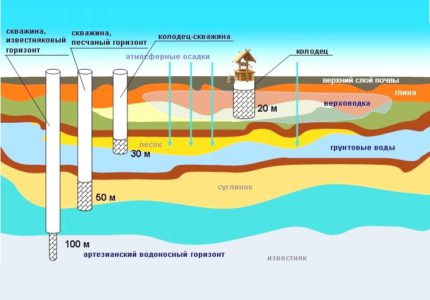
Visual Groundwater Search Methods
All methods used by experts to determine the depth of the aquifer are based on accumulated experience and centuries-old observations, as well as on the properties that groundwater possesses and on their impact on the environment.
The best option is when the methods described below are used comprehensively, because Despite the high reliability, none of the methods gives a 100% guarantee.
Method # 1 - vegetation on the site
A study of the vegetation of natural origin will help determine the level of occurrence of the high water in your area. Pay attention to those plants that even in the driest period remain green and juicy.
The approximate value of the depth of groundwater by plant type:
- cattail and reeds, sedge - 1-3 m;
- black poplar - 1-3 m;
- wormwood - 3-6 m;
- alfalfa - 10-15 m.
Such trees as cedar, willow, alder, and birch indicate a shallow occurrence of an aquifer. But the presence of a pine on the site opposite, suggests that groundwater lies deep enough. If well drilled for household purposes, then a site with similar vegetation is quite suitable.
Please note that annual plants are not indicators indicating the depth of the aquifer, becausethey have a short root system and receive the necessary moisture from natural rainfall, dew or waterlogging.
Method # 2 - terrain in the area of the site
In most cases, the aquifer repeats the terrain. That is why it is best to choose a lowering zone for drilling, because there the water will be closest to the surface. Also, longitudinal differences in the area indicate the presence of an aquifer, but it is rather difficult to notice them with an inexperienced gaze.
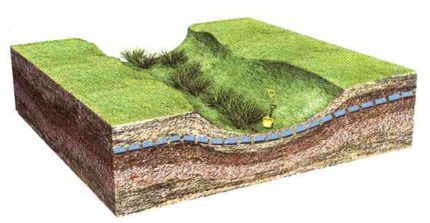
Despite the fact that lowlands are preferable for drilling, it is impossible to drill a well in wetlands, due to the fact that in case of depressurization of the production shaft, very poor quality water will flow into the well from the surface, while constantly flooding the sump.
Also the choice of location water wells depends on the characteristics of the soil: it is advisable to drill in the place where the soil is best amenable to development. In this case, sand, loam and sandy loam is much more preferable than rock.
Method # 3 - the effect of nearby water bodies
If there is a natural body of water (lake or river) within a radius of 300-500 m from your site, then with a high degree of probability the aquifer will be located anywhere in the site. In this case, the rule applies: the closer to the natural body of water, the higher and more abundant the aquifer will be.
Considering the remoteness of the site from a natural reservoir, do not forget to take into account such a factor as the discharge of sewage or industrial waste into it. In this case, the presence of a nearby lake or river will be more likely a negative phenomenon than a positive one.
This is especially true for sandy soils, which have high filtration rates, and if mechanical pollution on the way to your site is likely to be filtered out. But harmful chemical compounds are likely to fall into groundwater, and from there to the wellbore.
Clay rocks have low filtration characteristics, so the distance between the source of pollution and water intake can be slightly reduced. The installation of a well on a layer of sand lying between clay soils is possible.
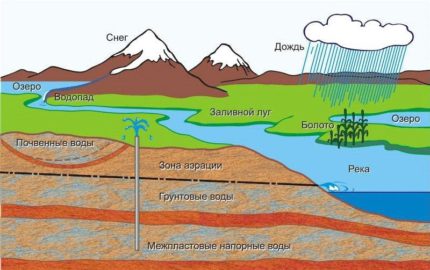
Method # 4 - omens and observations
There are folk signs that our ancestors used during groundwater search. Such signs include the abundance of morning dew in a certain territory, as well as the accumulation of evening fog haze. Such phenomena are very likely to indicate that groundwater is located close to the surface of the earth.
You can also make a prediction about the depth of the water by studying the behavior of pets in hot weather. Dogs do not like to lie where the aquifer comes close to the surface of the earth, but cats, on the contrary, choose such places for their pastime.
A small depth of water attracts insects; they swarm above such a place during and after sunset. But rodents and ants stay away from such places, preferring drier soils.
Of course, you shouldn’t fully rely on folk signs, but taking them into account in combination with other signs will not be superfluous. Using popular tips, you can determine the place for the device of the Abyssinian well.
Empirical ways to find groundwater
These methods include various methods that are well established in the search for groundwater in areas of various types. The implementation of these methods requires special equipment, measurements and analysis of the information received.
Despite the high accuracy, these methods also do not provide a 100% guarantee, however, in combination with visual signs, they can be considered reliable with full confidence.

Method # 1 - using a clay pot
An ancient method that our ancestors used to search for underground water. The principle of operation of this method is as follows: a dry clay pot is taken and installed for a day at the proposed location of the aquifer.
If after a day the pot inside was fogged up and its walls became wet, it was concluded that the water was close to the surface of the earth.
This method can be used in dry warm weather. To obtain more accurate results, it is recommended to use several clay pots, comparing their condition after 24 hours, which pot is the wettest inside, in that place and the depth of the aquifer is less.
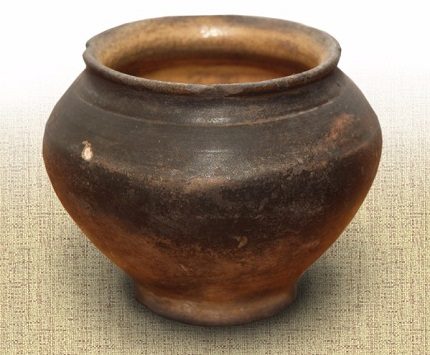
Method # 2 - use of silica gel
Silica gel is a synthetic polymer substance that can absorb moisture from the environment. Before use, the substance is thoroughly dried if it was stored in an open state. Silica gel is placed in a bag of natural fabric and weighed, it is enough to take 100-300 gr.
After that, the bag (or several bags) is buried at the points where it is supposed to place the aquifer at a depth of 0.8-1 m. After a day, the bags with silica gel are dug up and weighed.
In the place of greatest saturation with water, silica gel will absorb the greatest amount of moisture, which will affect its weight, it will increase 1.5-3 times. The greater the increase in weight, the closer the aquifer lies to the surface.
Instead of silica gel, you can use any desiccant, for example, pre-crushed and dried clay brick.
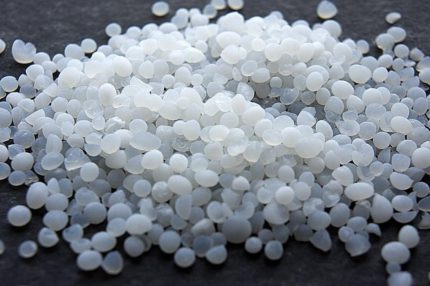
Method # 3 - electrical sensing
To search for groundwater using this method, special equipment is needed. It is impossible to do a search on your own in this case, you have to turn to professionals, however, the reliability of this method is very high.
The principle of action is as follows:
- at different points of the site measurements of soil resistivity are made;
- As a result of research, the aquifer is determined.
Groundwater is recorded in the place where the readings are from 50 to 200 ohms. The method is not suitable if there are underground utilities, metal structures, because devices will give false results.
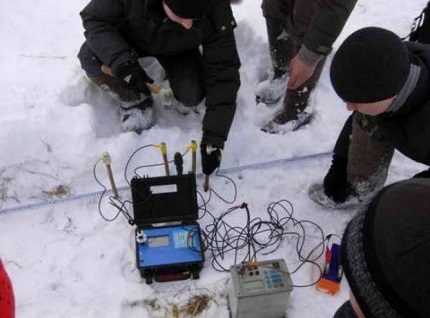
Method # 4 - frame search
The biolocation method is the most famous and at the same time controversial method. Some experts consider it effective and scientifically sound, while others call it quackery. Nevertheless, many cases have been documented when groundwater was found using dowsing.
To implement this method, it is necessary to prepare a framework of aluminum wire 50 cm long. The ends of the wire are bent at right angles. The frame is inserted into the branches of viburnum, hazel or elderberry.
The following actions are performed:
- Using a compass, cardinal points are determined and marked on the site.
- We slowly cross the section from north to south, and then from east to west, holding a dowsing frame in hand.
- In the place of occurrence of the aquifer, the frames begin to move.
- Moving in different directions and following the movement of the frame, we determine the direction of the aquifer.
The use of the frame is based on the action of magnetic fields, so this method is not suitable if the site soil contains a large amount of iron ore or there are radar towers nearby that distort the data of the radar frame.
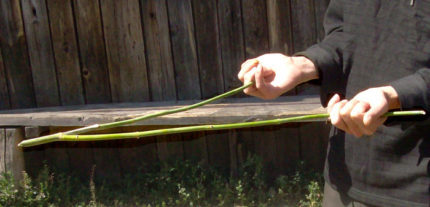
All the methods discussed above are widely used to search for the aquifer and location shallow well drilling or the Abyssinian well. However, as already mentioned, not one of them gives a guarantee that when you start drilling, you will encounter groundwater at the estimated depth.
Is there a way to determine the groundwater horizon in one place or another? Is it possible to accurately determine the depth of an aquifer? Yes, if you use the exploratory drilling method.
Reliable Exploration Drilling Search Method
The most reliable way to avoid annoying miscalculations is to look for official information about the hydrogeological situation of the site. Data can be obtained at the local drilling organization or in the weather service, which has all the characteristics of the geological and climatic specifics of the region.
To carry out independent reconnaissance, you can use the manual method, which does not require financial costs. Before starting drilling operations, it is necessary to prepare the required equipment: a hand drill, a shovel, and also take care of the storage location of the soil raised to the surface.
This method is suitable for soft soils that can be drilled using a hand drill. For denser rocks, drillers will have to be called up and more serious equipment used.
Advantages of exploratory drilling:
- 100% result of the search and determination of the depth of groundwater;
- the ability to assess groundwater;
- the ability to accurately calculate the cost of drilling.
An exploratory well, as a rule, is located in a place selected for organizing water intake. Those. nobody will conduct reconnaissance especially for the private trader - it’s expensive, because you have to pay for every drilled meter at the usual rate, and it’s pointless.
If there is no water in the well at an acceptable depth for exploitation, it is classified as exploratory and simply filled up with the soil extracted during drilling. No one will drill anything else on this site - it is useless. If a well has opened an aquifer, just equip the source and construct a water supply system based on water intake.
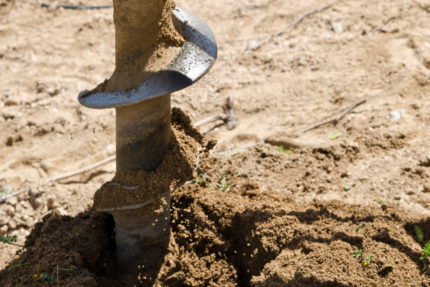
Unsuitable places for the well
The main condition for well devices on site is the presence of an aquifer. However, even with its observance in some cases, drilling a well is impossible.
Signs of unsuitability for the location of the well are:
- the presence in the immediate vicinity of sources of groundwater pollution;
- a place near the sewer system and wastewater;
- location near ecologically unfavorable natural reservoirs;
- close proximity of power lines and laying in the area of underground utilities;
- branched root trees.
Particular attention should be paid to compliance with sanitary standards, if they are violated, drilling of the well cannot be done.Also, do not place a well next to the fence of a neighboring site, because you cannot predict what a neighbor will build on his land in the immediate vicinity of your water source.
Well in the basement of the house
Many homeowners find placing a well in the basement of the house an ideal option.
Indeed, if the aquifer passes just in the area where the house is located or will be built, then this option will have many advantages:
- Significant simplification and cheapening of the process for installing water from the well;
- shortest water supply route;
- lack of need for insulation and the construction of a caisson.
If desired arrange water intake within the house, a well must be drilled at the construction site before the foundation is erected. Optimal - to reflect in the design of the house the presence of an aquifer in the basement.
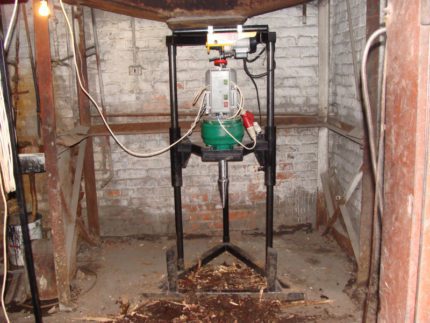
Disadvantages of locating an aquifer in the basement:
- enough space is required;
- difficulties with the installation of pumping equipment due to the inaccessibility of the well;
- problems during the flushing process with drainage;
- the possibility of erosion of the soil around the water source and the threat of subsidence of the foundation of the house.
At least 1 month must pass between the end of drilling and the beginning of the foundation. This period is necessary to identify and eliminate all problems associated with the operation of the well.
Consider that there should be enough space around the well for its maintenance or repair. The minimum size of the maintenance site is 3x4 meters.
Optimum time for drilling
Having decided the question of where it is best to drill an aquifer, it is necessary to decide when to drill. Experts believe that each season has its pros and cons for drilling operations. In one, they agree unanimously: you can’t drill a well in the spring.
There are several reasons for this:
- the presence of flood increases the level of groundwater;
- it is impossible to reliably determine the location and depth of an aquifer;
- spring thaw will complicate the passage of drilling equipment.
In most regions of Russia, drilling is not possible from March to May, in the northern regions from April to mid-June. In arid regions, it is also not recommended to carry out drilling operations in the spring even in the absence of high water, in this case the groundwater is still unstable, their level is noticeably increased.
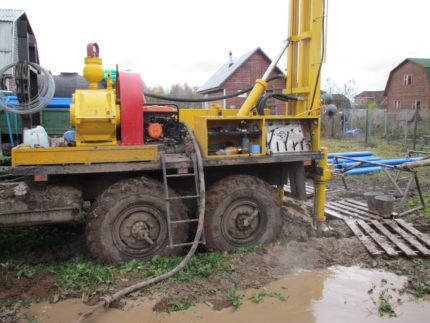
Summer-autumn period
The best time to build a well is July-September. At this time, the level of the overhead water is at the minimum mark, which means that it is possible to accurately determine the optimal horizon for the future well.
Also, the advantages of drilling in the summer-autumn period include:
- dryness and soil stability;
- the possibility of access of special equipment;
- comfortable temperature for drilling operations.
Many owners of the sites prefer to start work on the construction of wells in the fall after harvesting, so that special equipment does not damage the planting, and when washing the well there is no flooding of crops.
When planning the installation of a well for the period August-early September, keep in mind that companies engaged in drilling are busy at this time, so you need to agree on a date in advance.
Winter drilling
Winter is an ideal time for drilling artesian and sand wells to groundwater. In this case, the risk of errors in the incorrect determination of the aquifer is minimized, because the overhead does not interfere with the determination of the groundwater level.
Modern technology can easily cope with frozen ground, while minimizing the damage to the terrain of your site.
Flushing the well must be done, it is performed not only for pumping muddy water. Collapsed during drilling soil can clog the pump and immediately disable it. Because for pumping choose inexpensive Vibration type aggregateswith which it is not a pity to leave immediately.
An important factor: in the winter, the number of customers at drilling companies decreases, and therefore the cost of drilling work decreases.
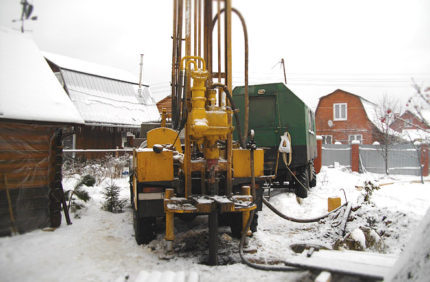
Conclusions and useful video on the topic
Clip # 1. The choice of the location of the drilling of an aquifer in the area:
Clip # 2. Practical application of the dowsing method when searching for water:
Clip # 3. Self-exploration video using a primitive drilling method:
Choosing the right place for a well is an important event on which the further operation of the water supply system of your site and home depends.
It is imperative to take into account sanitary standards, the location of the foundation. If possible, it is advisable to reduce the external water supply route if the system is supposed to be automated.
Those wishing to share their own experience in determining the optimal location for water intake at the suburban area are welcome to leave comments. If the proposed information contains contentious issues, ask questions. Please comment in the box below.

 Do-it-yourself well arrangement at the cottage: step-by-step instruction + advice from experienced craftsmen
Do-it-yourself well arrangement at the cottage: step-by-step instruction + advice from experienced craftsmen  DIY Abyssinian well construction: how to make an igloo-well on a site
DIY Abyssinian well construction: how to make an igloo-well on a site 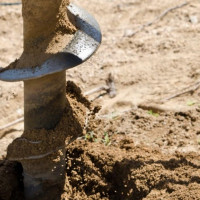 How to punch a well into water: options and drilling technologies that are in demand in practice
How to punch a well into water: options and drilling technologies that are in demand in practice 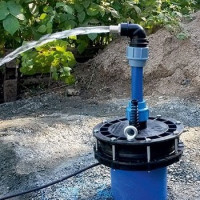 How to swing a well: methods for pumping after drilling and during operation
How to swing a well: methods for pumping after drilling and during operation 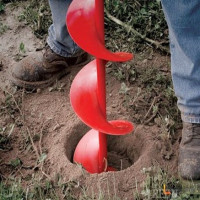 How to drill a well with your own hands: ways to budget independent drilling
How to drill a well with your own hands: ways to budget independent drilling  Well or well - which is better? Detailed comparative review
Well or well - which is better? Detailed comparative review  How much does it cost to connect gas to a private house: the price of organizing gas supply
How much does it cost to connect gas to a private house: the price of organizing gas supply  The best washing machines with dryer: model rating and customer tips
The best washing machines with dryer: model rating and customer tips  What is the color temperature of light and the nuances of choosing the temperature of the lamps to suit your needs
What is the color temperature of light and the nuances of choosing the temperature of the lamps to suit your needs  Replacement of a geyser in an apartment: replacement paperwork + basic norms and requirements
Replacement of a geyser in an apartment: replacement paperwork + basic norms and requirements
The material stated that the best time to drill a well is the time from July to September. But in the section “Drilling in the winter”, arguments are presented in favor of winter drilling as ideal. I'm a little confused, what time of year is it better to order this work? I am more inclined to winter so that the equipment does not leave large traces on the site.
Maybe I’ll tell someone a secret, but in winter it’s profitable to drill, not for drillers, but for customers. In winter, there are not many orders, so good discounts are made on services. As for seasonal conditions, there are also some nuances here. For example, it is better to drill a sand well in the dry period, since in this case it will be clear if there is water there.
If you are afraid for the safety of the site, it is best to drill not only in winter, but also during a drought. In this case, traces of heavy equipment will be minimized.
In general, at the end of summer and the beginning of autumn, this is the peak in drilling operations. Groundwater level is at a minimum, the earth is rammed, only dry soil remains on the site.
I drilled a well in August. Experts also said in the affirmative that there were no extraneous influencing factors to determine the depth. True, they themselves could not say for sure at what level the aquifer would open. I’m wondering, before grandfathers accurately determined whether there was water or not, and whether it was worth digging a well in this place at all, and now advanced technologies are still being used with proven methods. As a result, we drilled 35 meters. I have been using it for at least 2 years, there are no problems with water even in dry weather.
Can a well with a depth of 30 meters affect a nearby country house (cause a subsidence of the foundation)? The well is located at a distance of 1.5-2 m from the foundation of the country house.
In theory, ground failures, and with it foundation sediment, can cause incorrect and careless actions of unfortunate drillers. If the well has already been drilled, then there should be no subsidence.
And so there are people who generally do wells right inside the house’s perimeter. The truth is not clear how they are going to clean and maintain this well.
In this case, you can not worry about the safety of the foundation. The diameter of the well is small to damage the foundation. Yes, and you will pump water for domestic needs, and not on an industrial scale. So a cavity without water of critical dimensions under the foundation is not formed.